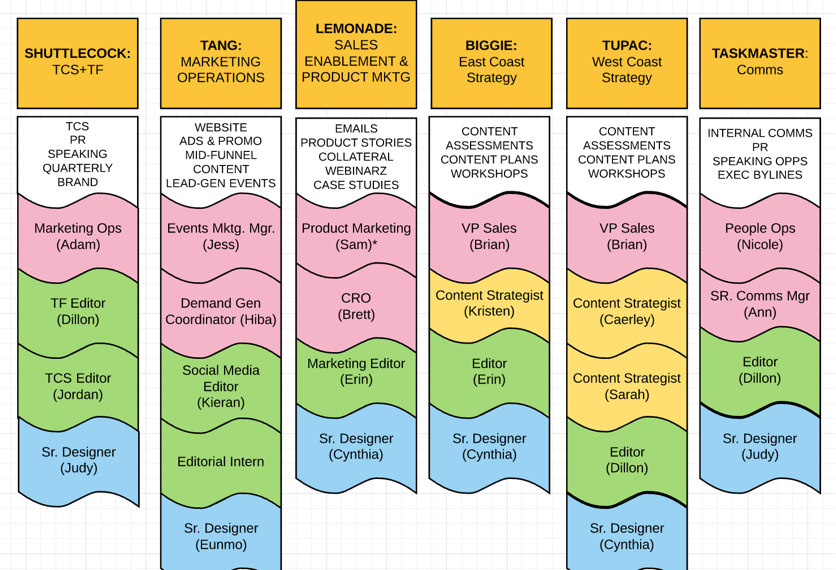ROI
How Agile Thinking Can Transform Your Content Marketing
Marrying content marketing to more traditional marketing functions sounds simple enough… until you try it.
Content and marketing actually require very different skills; putting a content creator in a marketing role, or vice versa, is like mixing vodka and milk.[note]There’s some debate, in the context of Mobb Deep’s “Survival of the Fittest,” as to whether “mixing vodka and milk” results in a negative or positive outcome. As in “We’re a VERY volatile combination, and likely to shoot you” or “We make a delightful pairing, like a White Russian.” For the purposes of this article, we’ll be going with option A.[/note] The people in these roles speak different languages: ROI and go-to-market vs. TKs and Oxford commas. Most of the marketers I talk to—and as a marketer at a marketing company, I talk to a lot of them—have some kind of horror story about trying to repurpose a junior marketing manager into a content marketer.
Another issue to consider is the traditional separation between creative and business functions within a company. Who among marketers hasn’t complained about the output and inscrutability of creative teams, and which creatives haven’t rolled their eyes at annoying requests from the front line? (I usually do both things on a daily basis.)
When you think about it, the larger challenge isn’t just marketing against content marketing, it’s how marketing and content support the front-line teams in general. How do you know that your content drives results? What does the feedback loop look like between marketing and sales? How can you create teams that support the middle and bottom of the funnel while still prioritizing top-line goals like reach, brand awareness, and lead generation?
As Contently has grown from a small startup with a well-read blog into a 120-person-strong company with a robust marketing operation, we’ve had to confront a lot of these dilemmas. We tried different systems, organizational structures, goals, and even different managers—none of which worked as well as we wanted.
It wasn’t until we took a page from agile product development that we finally saw the light.
How agile applies to marketing
Agile is a project-management process typically used by developers to break down a big project into a more manageable schedule that prioritizes different tasks. Instead of siloing different functions, you combine them. The point is to structure a team in a way that allows for fast iteration and efficient cross-departmental collaboration.
On Contently’s product team, this means engineers, UX designers, product managers, and data analysts work together on small teams to build and refine a new software feature. Each group has the personnel to complete a project without having to pass it off to anyone else.
Adopting this approach in marketing made us way more flexible. We could ideate, write, edit, design, and publish based on data and feedback. With fewer dependencies, we got more work done.
With fewer dependencies, we got more work done.
Now, each part of the marketing funnel gets a cross-functional team that includes a content creator, a marketer, and a designer. There’s often a member of the front-line teams assigned as well, as a kind of sponsor, to make sure the original idea behind the project doesn’t get lost. Since we already have “teams” within our marketing department (content, marketing, and design), we ran into a nomenclature issue, so we decided to christen these working groups “squads.”
Here’s how we visualize our agile squad structure:

Agile has allowed us to solve two of the biggest problems marketers face:
1. The unicorn problem
Marketing leaders obsess over finding that special creature good at both content and traditional marketing. Fun fact: Those people are really hard to find. Squads have solved that problem for us because people get to focus on their specialized skills.
This model could work even better for larger companies that have bigger pools of talent. Pairing a marketer with an editor allows you to get the best of both worlds. After enough time, each person will learn about other disciplines without needing to pretend like they’re already experts.
2. The “creative at scale” problem
Brands, especially big ones, need a steady stream of content to empower their various divisions and lines of business. But that need also leads to a situation where these companies not only have too many cooks, but they have too many kitchens as well.
Companies are building “content centers of excellence” or “brand newsrooms” so they can have a centralized place where people handle all creative work. Adding representatives from each teams that plan to use that work means you execute faster (because you’re not sitting around waiting for 900 approvals), but, more importantly, you don’t wind up with pieces of content that never get seen.
The nice thing about this structure is how it can grow as the company grows. Once we ask marketing and sales to provide more specialized functions, we can deploy our creative talent within squads that service those functions. We can have disparate teams pull together to take care of crucial projects. In the long run, that process will make our organization smarter, more harmonious, and more effective.
It may not be simple, but then again, neither is making a decent White Russian.
Image by Moment / GettyGet better at your job right now.
Read our monthly newsletter to master content marketing. It’s made for marketers, creators, and everyone in between.




